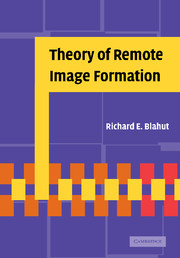Book contents
- Frontmatter
- Contents
- Preface
- Acknowledgements
- 1 Introduction
- 2 Signals in one dimension
- 3 Signals in two dimensions
- 4 Optical imaging systems
- 5 Antenna systems
- 6 The ambiguity function
- 7 Radar imaging systems
- 8 Diffraction imaging systems
- 9 Construction and reconstruction of images
- 10 Tomography
- 11 Likelihood and information methods
- 12 Radar search systems
- 13 Passive and baseband surveillance systems
- 14 Data combination and tracking
- 15 Phase noise and phase distortion
- References
- Index
14 - Data combination and tracking
Published online by Cambridge University Press: 19 August 2009
- Frontmatter
- Contents
- Preface
- Acknowledgements
- 1 Introduction
- 2 Signals in one dimension
- 3 Signals in two dimensions
- 4 Optical imaging systems
- 5 Antenna systems
- 6 The ambiguity function
- 7 Radar imaging systems
- 8 Diffraction imaging systems
- 9 Construction and reconstruction of images
- 10 Tomography
- 11 Likelihood and information methods
- 12 Radar search systems
- 13 Passive and baseband surveillance systems
- 14 Data combination and tracking
- 15 Phase noise and phase distortion
- References
- Index
Summary
Some types of large data sets have a hierarchal substructure that leads to new kinds of surveillance algorithms for tasks such as data combination and tracking. The term data combination typically refers to a task in which several estimates based on partial data are combined. Perhaps several snapshots of the same scene or object are available, and multiple measurements or estimates are to be combined or averaged in some way. The topics of this chapter refer to partially processed data, and the methods may be used subsequent to correlation or tomographic processing.
Various sets of data may be combined either before detection or after detection. The combination of closely associated data prior to detection is called integration, and can be either coherent integration or noncoherent integration. The combination of data from multiple sensors, usually in the form of parameters that have been estimated from the data, is called data fusion. This term usually conveys an emphasis that there is a diversity of types of data. Sometimes, only a tentative detection is made before tracking, while a hard detection is deferred until after tracking. In some applications, this is called “track before detect.” In this chapter, we shall study the interplay between the functions of detection, data fusion, and tracking, which leads us to think of sensor processing on a much longer time scale than in previous chapters.
- Type
- Chapter
- Information
- Theory of Remote Image Formation , pp. 481 - 498Publisher: Cambridge University PressPrint publication year: 2004



